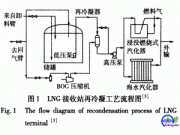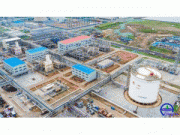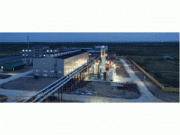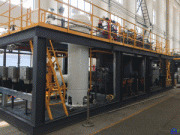免职声明:本网站为公益性网站,部分信息来自网络,如果涉及贵网站的知识产权,请及时反馈,我们承诺第一时间删除!
This website is a public welfare website, part of the information from the Internet, if it involves the intellectual property rights of your website, please timely feedback, we promise to delete the first time.
电话Tel: 19550540085: QQ号: 929496072 or 邮箱Email: Lng@vip.qq.com
摘要:液化天然气:Liquefied Natural Gas The Center for Liquefied Natural Gas (CLNG) provides comprehensive and reliable information about LNG. CLNG strives to be a clearinghouse of information by providing educational and technical information, so that t..
|
液化天然气:Liquefied Natural Gas The Center for Liquefied Natural Gas (CLNG) provides comprehensive and reliable information about LNG. CLNG strives to be a clearinghouse of information by providing educational and technical information, so that those interested in LNG and the LNG industry can easily obtain the data they want. The following are answers to frequently asked questions about LNG. What is LNG? What is LNG?LNG stands for liquefied natural gas. It is natural gas cooled to approximately RETURN TO TOP How is LNG created from natural gas? How is it re-gasified? Is this conversion safe?The conversion of natural gas into liquid is called liquefaction and is achieved through refrigeration. Liquefaction reduces the volume of natural gas by approximately 600 times, making it more economical to transport in specially designed ships. LNG is converted back to gas by passing the liquid through vaporizers that warm it above -260° F. Both the liquefaction and regasification processes are performed using advanced technologies with proven safety records. RETURN TO TOP Where does LNG come from?Most LNG is imported to the United States from Trinidad and Tobago, Qatar, Algeria, Nigeria, Australia and Indonesia. It is transported in large, modern LNG carriers to one of five U.S. import terminals in:
Upon reaching its destination, LNG is stored as a liquid before being turned back into a gas and sent out via pipelines as natural gas. Even though there are only five import terminals in the United States, there are more than 100 LNG production, transport and storage facilities across the country. The United States also exports LNG to Japan from Kenai, Alaska. Without a pipeline or a LNG import terminal on the West Coast, it is impossible to bring the Alaskan natural gas to the lower 48 states for domestic consumption. RETURN TO TOP Why is there so much interest in LNG?LNG is not new. It has been successfully transported and used for almost 100 years. However, in the summer of 2003, Alan Greenspan, as chairman of the Federal Reserve, flagged LNG as a "hot topic," raising awareness of the need to expand our energy sources. He said LNG could play an integral part in meeting our nation's future energy demands. Then, in October 2003, the National Petroleum Council (NPC) released a study about the long-term outlook for natural gas. The study highlighted using LNG to help create a more balanced energy future. The U.S. Department of Energy forecasts that U.S. LNG imports should increase to more than 4.4 trillion cubic feet, or 16% of U.S. natural gas consumption, by 2030. RETURN TO TOP What are the advantages of LNG?LNG takes up a much smaller fraction of space than natural gas. Six hundred cubic feet of natural gas turns into just one cubic foot of liquefied natural gas. In areas where geologic conditions are not suitable for developing underground gas storage facilities, LNG has provided the opportunity to economically store natural gas. The gas is stored at what are called peak-shaving facilities, for use during high-demand periods. It is stored as a liquid at these facilities until it is needed, at which point it is returned to its gaseous state and sent through pipelines to consumers. Since the volume of LNG is 600 times smaller than natural gas, it is more efficiently transported over long distances by sea. This takes place in specially designed ships. The real advantage is that LNG allows us to import natural gas from other countries around the world. This expands and diversifies U.S. natural gas supplies, which in turn increases supply reliability and security. RETURN TO TOP How does the United States benefit from LNG?LNG can help meet the growing demand for natural gas in the United States. Natural gas demand is projected to increase by 18% between 2004 and 2017. It is in such high demand particularly because it is a clean-burning fuel. Many of the electricity generating plants around the country rely on natural gas to produce electricity. LNG also enables the country to diversify its sources of energy supply, strengthening our energy security. RETURN TO TOP Is LNG likely to meet the nation’s growing energy demands?LNG alone cannot meet the growing demand. However, along with developing our domestic energy resources, it can be an integral component of our energy future. RETURN TO TOP What role does LNG play in our nation’s energy portfolio?LNG currently accounts for 2.8% of our natural gas consumption – less than 1% of the energy our nation uses. However, as domestic demand for natural gas increases, we will need to look elsewhere for new supplies. LNG is already fast-becoming a global commodity. A U.S. Department of Energy study projects U.S. LNG imports to increase to more than 4.4 trillion cubic feet, or 16% of U.S. natural gas consumption, by 2030. Learn more about LNG’s role in our energy portfolio in LNG Future. RETURN TO TOP Can LNG be shipped safely?Yes. LNG has an excellent safety record. In LNG’s 45-plus year shipping history, LNG carriers have conducted more than 40,000 voyages worldwide, traveling more than 100 million miles without a major incident. Over the life of the industry only eight marine incidents worldwide have resulted in accidental spillage of LNG. In these cases no fires occurred and only minor structural damage was noted. Seven additional marine-related incidents have occurred with none resulting in release of cargo. No explosions or fatalities from a cargo spill have ever occurred aboard an LNG carrier. Learn more about the LNG industry’s safety record in LNG Safety & Security. RETURN TO TOP Can LNG leak from a storage tank?There are numerous layers of robust safety and security systems in place to prevent any such incidents. There are also monitoring systems in place to quickly detect a leak and trigger the safety systems. Storage tanks are built with multiple layers of containment. There is an external dike around the tank designed to contain its entire contents. Beyond this dual containment system required by federal regulations, many modern tanks have two walls – an inner wall of high nickel steel surrounded by a wall of concrete, generally three feet thick. Should the inner steel wall fail, the outer concrete tanks will contain the LNG. Learn more about storage tank safety in LNG Facility Safety. RETURN TO TOP Will it burn if it is released into the air or in storage facilities?Should a tank ever fail and a leak result, fire is possible, but only if there is the right concentration of LNG vapor in the air (5% – 15%) and a source of ignition within this concentration zone. Regulations require safety zones around LNG facilities. Setback distances must be great enough so that flammable vapors will not reach the facilities’ property lines and radiation from a potential fire will not impact those beyond the facilities’ property line. RETURN TO TOP Would a spill of LNG result in a polluting slick?No. If spilled, LNG would not result in a slick. Absent an ignition source, LNG evaporates quickly and disperses, leaving no residue. There is no environmental cleanup needed for LNG water spills. Learn more about LNG environmental affects, see Environmental Health. RETURN TO TOP Are there restrictions for LNG facilities’ proximity to residential areas?Yes. The federal government's U.S. Code of Federal Regulations specifies that LNG containers and transfer systems must be far enough away from residential areas to protect residents and property in case of an accident. The distance depends on various factors, including storage tank design. RETURN TO TOP Doesn’t the January 2004 explosion at an LNG facility in Algeria prove that LNG is dangerous?No. The Algeria explosion took place at an LNG export liquefaction plant – not an import terminal. A board of inquiry determined that a gas leak was the primary cause of the accident. A nearby boiler was the source of the ignition, which ignited the vapor cloud in a confined space causing an explosion and fire. LNG import terminals do not use steam boilers. It should be noted that even the resulting fire did not damage LNG storage tanks that are similar to those that would be used at an import terminal. RETURN TO TOP Could the United States potentially become vulnerable economically due to reliance on foreign LNG resources?While approximately 60% of oil demand in the United States is met by imports, LNG's current share in U.S. gas consumption is approximately 2.8%. The U.S. Department of Energy’s projections forecast it to increase to about 16% of total U.S. natural gas consumption, by 2030. In addition, world natural gas resources are more abundant and more evenly distributed throughout the world than are oil supplies, which allow the United States to ensure a more secure and diversified natural gas supply. RETURN TO TOP Are LNG facilities or ships likely terrorist targets?All parts of our critical energy infrastructure have been reassessed since the terrorist attacks of September 11, 2001. Security consciousness throughout the United States is heightened. Shippers have redoubled their already-stringent efforts to ensure security of transportation and the safety of terminals. There is no indication that LNG facilities or ships are more likely terrorist targets than other cargo ships or higher visibility political targets such as federal or state landmarks, transportation infrastructures, public gatherings or bridges and tunnels. Nonetheless, LNG suppliers work closely with U.S. agencies charged with national security, and many developers contract with international experts who test their plans, procedures, people and training to ensure they are sound. First, stringent access controls exist at both the point of origin and the point of destination. Both the liquefaction and LNG import terminals have gated security access and continuous surveillance monitoring. Second, highly specialized, well-trained personnel serve as crewmembers, whose backgrounds have been thoroughly checked by the authorities. Before an LNG ship enters U.S. waters, the immigration service validates the crew. There is a safety zone required between carriers and other traffic, and tugboats control the direction of carriers as they approach a terminal. Oversight is handled by the U.S. Coast Guard and host port authority pilots. Finally, the U.S. Coast Guard boards ships before they enter U.S. waters if it is deemed necessary. RETURN TO TOP What are some of the measures taken to ensure LNG storage facilities’ safety?LNG facilities’ safety requirements along with the industry standards and best practices, are designed to ensure the safety and security of all LNG facilities. Storage tanks and other equipment must be made of suitable materials with the proper engineering design. There are secondary containment systems - designed to hold more than the storage tank - to ensure isolation and control of LNG if a leak occurs. When necessary, LNG storage tanks are double-walled to further enhance their integrity. In other instances, adikesurrounds storage tanks, ensuring LNG is contained on site and does not leak into drainage systems.Some locations contain both double-walled tanks and a system of dikes.There are also safeguard systems, such as gas, liquid and fire detectors to identify any failures as well as remote and automatic shut-off systems to minimize leaks and spills. Finally, LNG facility designs are required to maintain separation distances to separate land-based facilities from neighborhoods and other public areas. RETURN TO TOP |

















